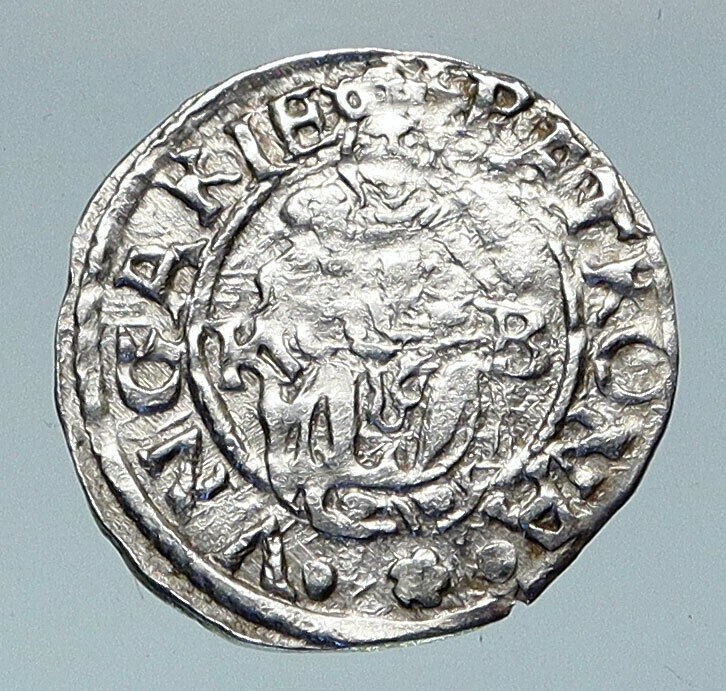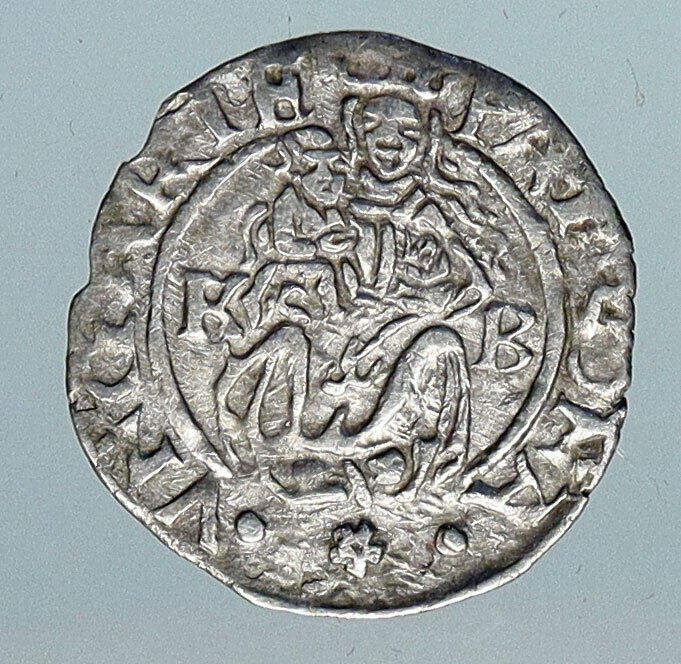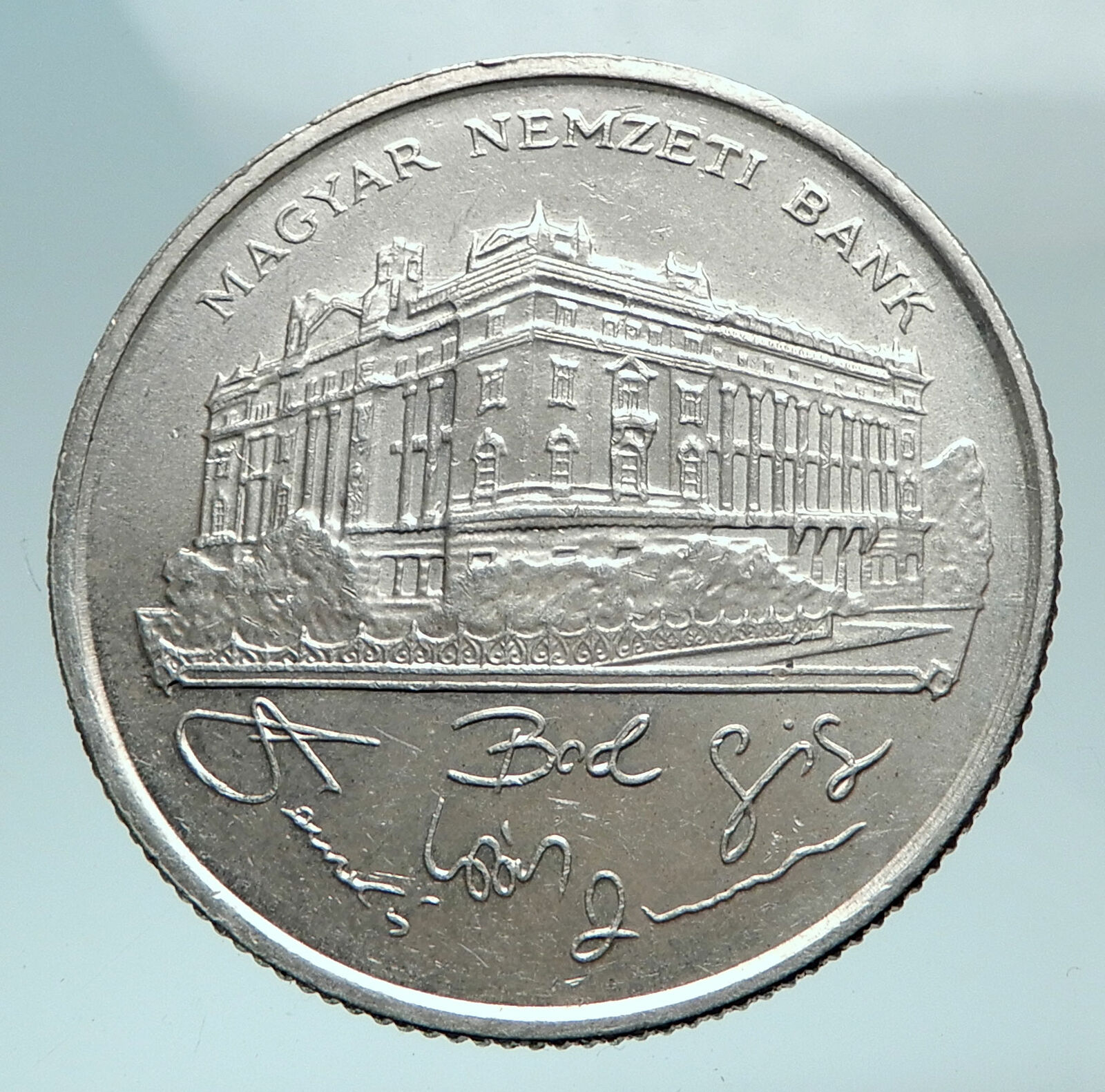|
Hungary under Ferdinand I – Holy Roman Emperor – 27 August 1556 – 25 July 1564
1528-58 Silver Denar 15mm (0.50 grams) 0.500 Silver
Reference: ÉH# 745, H# 935, H# 937, H# 939, H# 953 (1528-59)
* FERDINAND · D · G · R · VNG * 1537, Fourfold curved coat of arms: Hungarian Árpád stripes, Hungarian double cross, Dalmatian leopard heads, Bohemian lion; in center chest shield Austrian bonds.
PATRONA * * VNGARIE, Crowned Madonna with child in her right arm.
You are bidding on the exact item pictured, provided with a Certificate of Authenticity and Lifetime Guarantee of Authenticity.
 Ferdinand I (Spanish: Fernando I) (10 March 1503 – 25 July 1564) was Holy Roman Emperor from 1556, king of Bohemia and Royal Hungary from 1526, and king of Croatia from 1527 until his death in 1564. Before his accession, he ruled the Austrian hereditary lands of the Habsburgs in the name of his elder brother, Charles V, Holy Roman Emperor. Also, he often served as Charles’ representative in Germany and developed encouraging relationships with German princes. Ferdinand I (Spanish: Fernando I) (10 March 1503 – 25 July 1564) was Holy Roman Emperor from 1556, king of Bohemia and Royal Hungary from 1526, and king of Croatia from 1527 until his death in 1564. Before his accession, he ruled the Austrian hereditary lands of the Habsburgs in the name of his elder brother, Charles V, Holy Roman Emperor. Also, he often served as Charles’ representative in Germany and developed encouraging relationships with German princes.
The key events during his reign were the contest with the Ottoman Empire, which in the 1520s began a great advance into Central Europe, and the Protestant Reformation, which resulted in several wars of religion. Ferdinand was able to defend his realm and make it somewhat more cohesive, but he could not conquer the major part of Hungary. His flexible approach to Imperial problems, mainly religious, finally brought more result than the more confrontational attitude of his brother.
Ferdinand’s motto was Fiat iustitia, et pereat mundus: “Let justice be done, though the world perish”.
Ferdinand was born in Alcalá de Henares, Spain, the second son of Queen Joanna I of Castile from the House of Trastámara (herself the daughter of the Catholic Monarchs Isabel I of Castile and Ferdinand of Aragon) and Habsburg Archduke Philip the Handsome, who was heir to Maximilian I, Holy Roman Emperor. Ferdinand shared his customs, culture, name, and even his birthday with his maternal grandfather Ferdinand II of Aragon. He was born, raised, and educated in Spain, and did not learn German when he was young.
In the summer of 1518 Ferdinand was sent to Flanders following his brother Charles’s arrival in Spain as newly appointed King Charles I the previous autumn. Ferdinand returned in command of his brother’s fleet but en route was blown off-course and spent four days in Kinsale in Ireland before reaching his destination. With the death of his grandfather Maximilian I and the accession of his now 19-year-old brother, Charles V, to title of Holy Roman Emperor in 1519, Ferdinand was entrusted with the government of the Austrian hereditary lands, roughly modern-day Austria and Slovenia. He was Archduke of Austria from 1521 to 1564. Though he supported his brother, Ferdinand also managed to strengthen his own realm. By adopting the German language and culture late in his life, he also grew close to the German territorial princes.
After the death of his brother-in-law Louis II, Ferdinand ruled as King of Bohemia and Hungary (1526-1564). Ferdinand also served as his brother’s deputy in the Holy Roman Empire during his brother’s many absences, and in 1531 was elected King of the Romans, making him Charles’s designated heir in the empire. Charles abdicated in 1556 and Ferdinand adopted the title “Emperor elect”, with the ratification of the Imperial diet taking place in 1558, while Spain, the Spanish Empire, Naples, Sicily, Milan, the Netherlands, and Franche-Comté went to Philip, son of Charles.
_-_Google_Art_Project.jpg/220px-Sandro_Botticelli_-_The_Virgin_and_Child_(The_Madonna_of_the_Book)_-_Google_Art_Project.jpg) A Madonna is a representation of Mary, either alone or with her child Jesus. These images are central icons for both the Catholic and Orthodox churches. The word is from Italian ma donna, meaning ‘my lady’. The Madonna and Child type is very prevalent in Christian iconography, divided into many traditional subtypes especially in Eastern Orthodox iconography, often known after the location of a notable icon of the type, such as the Theotokos of Vladimir, Agiosoritissa, Blachernitissa, etc., or descriptive of the depicted posture, as in Hodegetria, Eleusa, etc. A Madonna is a representation of Mary, either alone or with her child Jesus. These images are central icons for both the Catholic and Orthodox churches. The word is from Italian ma donna, meaning ‘my lady’. The Madonna and Child type is very prevalent in Christian iconography, divided into many traditional subtypes especially in Eastern Orthodox iconography, often known after the location of a notable icon of the type, such as the Theotokos of Vladimir, Agiosoritissa, Blachernitissa, etc., or descriptive of the depicted posture, as in Hodegetria, Eleusa, etc.
The term Madonna in the sense of “picture or statue of the Virgin Mary” enters English usage in the 17th century, primarily in reference to works of the Italian Renaissance. In an Eastern Orthodox context, such images are typically known as Theotokos. “Madonna” may be generally used of representations of Mary, with or without the infant Jesus, is the focus and central figure of the image, possibly flanked or surrounded by angels or saints. Other types of Marian imagery have a narrative context, depicting scenes from the Life of the Virgin, e.g. the Annunciation to Mary, are not typically called “Madonna”.
The earliest depictions of Mary date still to Early Christianity (2nd to 3rd centuries), found in the Catacombs of Rome. These are in a narrative context. The classical “Madonna” or “Theotokos” imagery develops from the 5th century, as Marian devotion rose to great importance after the Council of Ephesus formally affirmed her status as “Mother of God or Theotokos (“God-bearer”) in 431. The Theotokos iconography as it developed in the 6th to 8th century rose to great importance in the high medieval period (12th to 14th centuries) both in the Eastern Orthodox and in the Latin spheres. According to a tradition recorded in the 8th century, Marian iconography goes back to a portrait drawn from life by Luke the Evangelist, with a number of icons (such as the Panagia Portaitissa) claimed to either represent this original icon or to be a direct copy of it. In the Western tradition, depictions of the Madonna were greatly diversified by Renaissance masters such as Duccio, Leonardo da Vinci, Michelangelo, Raphael, Giovanni Bellini, Caravaggio and Rubens (and further by certain modernists, such as Salvador Dalí and Henry Moore) while Eastern Orthodox iconography adheres more closely to the inherited traditional types.

 Hungary is a sovereign state in Europe. It is situated in the Carpathian Basin and is bordered by Slovakia to the north, Romania to the east, Serbia to the south, Croatia to the southwest, Slovenia to the west, Austria to the northwest, and Ukraine to the northeast. The country’s capital and largest city is Budapest. Hungary is a member of the European Union, NATO, the OECD, the Visegrád Group, and the Schengen Area. The official language is Hungarian, which is the most widely spoken non-Indo-European language in Europe. Hungary is a sovereign state in Europe. It is situated in the Carpathian Basin and is bordered by Slovakia to the north, Romania to the east, Serbia to the south, Croatia to the southwest, Slovenia to the west, Austria to the northwest, and Ukraine to the northeast. The country’s capital and largest city is Budapest. Hungary is a member of the European Union, NATO, the OECD, the Visegrád Group, and the Schengen Area. The official language is Hungarian, which is the most widely spoken non-Indo-European language in Europe.
 Following centuries of successive habitation by Celts, Romans, Huns, Slavs, Gepids, and Avars, the foundation of Hungary was laid in the late 9th century by the Hungarian grand prince Árpád in the Honfoglalás (“homeland-conquest”). His great-grandson Stephen I ascended to the throne in 1000 CE, converting the country to a Christian kingdom. By the 12th century, Hungary became a middle power within the Western world, reaching a golden age by the 15th century. Following the Battle of Mohács in 1526 and about 150 years of partial Ottoman occupation (1541-1699), Hungary came under Habsburg rule, and later formed a significant part of the Austro-Hungarian Empire (1867-1918). Following centuries of successive habitation by Celts, Romans, Huns, Slavs, Gepids, and Avars, the foundation of Hungary was laid in the late 9th century by the Hungarian grand prince Árpád in the Honfoglalás (“homeland-conquest”). His great-grandson Stephen I ascended to the throne in 1000 CE, converting the country to a Christian kingdom. By the 12th century, Hungary became a middle power within the Western world, reaching a golden age by the 15th century. Following the Battle of Mohács in 1526 and about 150 years of partial Ottoman occupation (1541-1699), Hungary came under Habsburg rule, and later formed a significant part of the Austro-Hungarian Empire (1867-1918).
Hungary’s current borders were first established by the Treaty of Trianon (1920) after World War I, when the country lost 71% of its territory, 58% of its population, and 32% of ethnic Hungarians. Following the interwar period, Hungary joined the Axis Powers in World War II, suffering significant damage and casualties. Hungary came under the influence of the Soviet Union, which contributed to the establishment of a four-decade-long communist dictatorship (1947-1989). The country gained widespread international attention regarding the Revolution of 1956 and the seminal opening of its previously-restricted border with Austria in 1989, which accelerated the collapse of the Eastern Bloc.
On 23 October 1989, Hungary again became a democratic parliamentary republic, and today has a high-income economy with a very high Human Development Index. Hungary is a popular tourist destination attracting 10.675 million tourists a year (2013). It is home to the largest thermal water cave system and the second-largest thermal lake in the world (Lake Hévíz), the largest lake in Central Europe (Lake Balaton), and the largest natural grasslands in Europe (the Hortobágy National Park).
|





 Ferdinand I (Spanish: Fernando I) (10 March 1503 – 25 July 1564) was Holy Roman Emperor from 1556, king of Bohemia and Royal Hungary from 1526, and king of Croatia from 1527 until his death in 1564. Before his accession, he ruled the Austrian hereditary lands of the Habsburgs in the name of his elder brother, Charles V, Holy Roman Emperor. Also, he often served as Charles’ representative in Germany and developed encouraging relationships with German princes.
Ferdinand I (Spanish: Fernando I) (10 March 1503 – 25 July 1564) was Holy Roman Emperor from 1556, king of Bohemia and Royal Hungary from 1526, and king of Croatia from 1527 until his death in 1564. Before his accession, he ruled the Austrian hereditary lands of the Habsburgs in the name of his elder brother, Charles V, Holy Roman Emperor. Also, he often served as Charles’ representative in Germany and developed encouraging relationships with German princes. _-_Google_Art_Project.jpg/220px-Sandro_Botticelli_-_The_Virgin_and_Child_(The_Madonna_of_the_Book)_-_Google_Art_Project.jpg) A Madonna is a representation of Mary, either alone or with her child Jesus. These images are central icons for both the Catholic and Orthodox churches. The word is from Italian ma donna, meaning ‘my lady’. The Madonna and Child type is very prevalent in Christian iconography, divided into many traditional subtypes especially in Eastern Orthodox iconography, often known after the location of a notable icon of the type, such as the Theotokos of Vladimir, Agiosoritissa, Blachernitissa, etc., or descriptive of the depicted posture, as in Hodegetria, Eleusa, etc.
A Madonna is a representation of Mary, either alone or with her child Jesus. These images are central icons for both the Catholic and Orthodox churches. The word is from Italian ma donna, meaning ‘my lady’. The Madonna and Child type is very prevalent in Christian iconography, divided into many traditional subtypes especially in Eastern Orthodox iconography, often known after the location of a notable icon of the type, such as the Theotokos of Vladimir, Agiosoritissa, Blachernitissa, etc., or descriptive of the depicted posture, as in Hodegetria, Eleusa, etc. 
 Hungary is a sovereign state in Europe. It is situated in the Carpathian Basin and is bordered by Slovakia to the north, Romania to the east, Serbia to the south, Croatia to the southwest, Slovenia to the west, Austria to the northwest, and Ukraine to the northeast. The country’s capital and largest city is Budapest. Hungary is a member of the European Union, NATO, the OECD, the Visegrád Group, and the Schengen Area. The official language is Hungarian, which is the most widely spoken non-Indo-European language in Europe.
Hungary is a sovereign state in Europe. It is situated in the Carpathian Basin and is bordered by Slovakia to the north, Romania to the east, Serbia to the south, Croatia to the southwest, Slovenia to the west, Austria to the northwest, and Ukraine to the northeast. The country’s capital and largest city is Budapest. Hungary is a member of the European Union, NATO, the OECD, the Visegrád Group, and the Schengen Area. The official language is Hungarian, which is the most widely spoken non-Indo-European language in Europe. Following centuries of successive habitation by Celts, Romans, Huns, Slavs, Gepids, and Avars, the foundation of Hungary was laid in the late 9th century by the Hungarian grand prince Árpád in the Honfoglalás (“homeland-conquest”). His great-grandson Stephen I ascended to the throne in 1000 CE, converting the country to a Christian kingdom. By the 12th century, Hungary became a middle power within the Western world, reaching a golden age by the 15th century. Following the Battle of Mohács in 1526 and about 150 years of partial Ottoman occupation (1541-1699), Hungary came under Habsburg rule, and later formed a significant part of the Austro-Hungarian Empire (1867-1918).
Following centuries of successive habitation by Celts, Romans, Huns, Slavs, Gepids, and Avars, the foundation of Hungary was laid in the late 9th century by the Hungarian grand prince Árpád in the Honfoglalás (“homeland-conquest”). His great-grandson Stephen I ascended to the throne in 1000 CE, converting the country to a Christian kingdom. By the 12th century, Hungary became a middle power within the Western world, reaching a golden age by the 15th century. Following the Battle of Mohács in 1526 and about 150 years of partial Ottoman occupation (1541-1699), Hungary came under Habsburg rule, and later formed a significant part of the Austro-Hungarian Empire (1867-1918).




